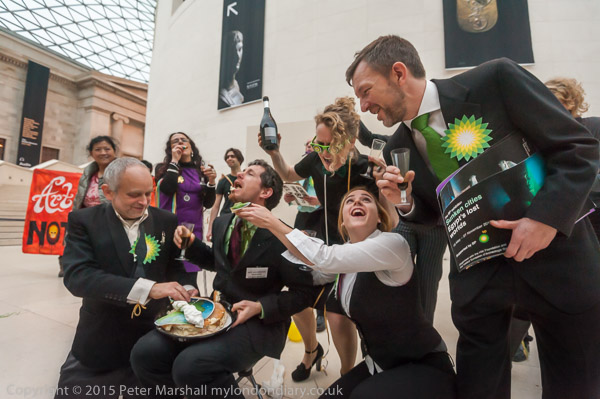We are by now rather used to hearing about various environmental disasters connected with BP, most notably the Deepwater Horizon oil spill in the Gulf of Mexico, widely accepted as the ‘worst environmental disaster‘ in US history. On the pages of Platform you can read their Picture This which looks at 25 years of BP from 1989-2014, listing for each year just the major incident or political shenanigans from each year that blackens their record – beginning with the Exxon Valdez shedding between 260,000 and 750,000 barrels of crude into the fragile coastal ecosystem of Alaska and travelling around the world, including Azerbaijan, Colombia, the North Sea, Papua New Guinea, Algeria, Ukraine, Canada, Libya and Iraq as well as the US.
The latest entry, for 2014, was as follows:
In March BP’s Whiting refinery in Indiana spilled between 470 and 1228 gallons of crude oil into Lake Michigan, a drinking water source for some seven million Chicago residents. The refinery has also been criticised for being responsible for huge black mountains of ‘high-sulfur, high-carbon risk petcoke’ along the Calumet River, a by-product of tar sands production.
Next door to that Whiting refinery is the ‘historic’ US town, Marktown, ‘built in 1917 by Chicago Industrialist Clayton Mark Sr. and was designed to be used as housing for his rapidly expanding Indiana Harbor Works of the Mark Manufacturing Company of Evanston, Illinois.’
According to an article on the New York Times Lens blog, Surrounded by Industry, a Historic Community Fights for Its Future, BP has been buying up properties in Marktown and demolishing them with the intention of demolishing the entire area, one which (to quote from Wikipedia)
‘is regarded as an important cultural resource of architectural and historical significance. In the words of the Marktown Revitalization Plan commissioned by the city of East Chicago in 2008, “Marktown is significant as it is a major work by a significant American architect, Howard Van Doren Shaw, for its association with the driving economic force of industry that served as an identity of the region, and is representative of the planned industrial community movement of the late 19th and early 20th century.’
The Lens article by David Gonzalez looks at the photographs in this small, isolated and tightly bonded community by Alyssa Schukar, a Chicago freelancer whose work on women’s American football gained her third place in the 2014 World Press Photo for Sports feature stories.

This was a story about BP I’d not heard before, although I’ve photographed a number of protests related to their other activities, such as a protest against the BP Baku-Tbilisi-Ceyhan Pipeline in 2006, the Canadian Tar Sands Oily-Olympics and a Picket for Colombian Oil Workers in 2010, the fabulous Rev Billy’s BP Tate Exorcism in 2011 (picture above)

up to last December’s End BP’s British Museum Greenwash, and most recently of all an image or two of Greenpeace’s splendid ‘Sinking Cities’ banners on the British Museumm’s portico last month. There are too many protests to list them all, but you can see more from a search on My London Diary for ‘BP’.
______________________________________________________
There are no adverts on this site and it receives no sponsorship, and I like to keep it that way. But it does take a considerable amount of my time and thought, and if you enjoy reading it, the occasional small donation – perhaps the cost of a beer – would be appreciated.
My London Diary : Buildings of London : River Lea/Lee Valley : London’s Industrial Heritage
All photographs on this and my other sites, unless otherwise stated, are taken by and copyright of Peter Marshall, and are available for reproduction or can be bought as prints.